Chris Baty's Blog, page 196
December 23, 2013
Come Write In Anywhere! Arndís Þórarinsdóttir On Making Your Writing Go Somewhere
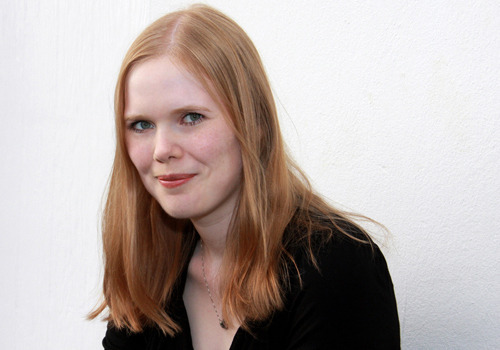
Our Come Write In program has partnered with bookstores and libraries around the world for four years. This November, for the first time, we welcomed community spaces of all kinds to become novel-writing havens. Intern Steve Genise chats with Icelandic Librarian Arndis Thorarinsdottir to discuss the finer points of North Germanic linguistics, and what it’s like to be an international writer.
Arndis, thank you for joining me via the magic of the interwebs! Have you participated in NaNoWriMo in the past?
The Kópavogur Public Library has hosted NaNoWriMo since 2007, offering Wrimos a friendly space where you can get plenty of coffee, a selection of writing prompts, NaNo bookmarks and much needed support from fellow NaNo-heros. Naturally Wrimos are welcome any day of the week, but designated write-ins were held every Saturday in November. This year was one of the good ones—five Saturdays in November!
Incidentally, 2007 was also the first year I finished NaNo myself. I managed to finish again in 2009, and sold that book in 2011. That was my first published novel.
Tell us about your writing process! Do you plan?
For the first NaNo I completed I decided to fly by the seat of my pants. I had an idea of plot—or really, just some interesting situations—and some fleshed-out characters, but not much else. It worked out okay, in the sense that I completed a manuscript that had a beginning, a middle, and an end, but once NaNo was over I was too overwhelmed to edit it properly. The changes I needed to make were too dramatic; I simply wasn‘t up to it.
Thus came my second proper attempt, where I set off with a firm outline. I did some character-developing exercises before starting, mapped out my entire storyline, etc. I really enjoyed that, and while the end product certainly needed a lot of work, it felt much more manageable.
Having two young kids, a home to run, a husband to spend time with and a job (dreadfully time consuming, those things. Hours upon hours a day, I tell you!), I‘m very protective of my time—I don‘t have much tolerance for writing things that don‘t go anywhere. That‘s not to say that I‘m not willing to explore my story in ways that don‘t necessarily end up in the finished product, but that the exploring must have a clear point and purpose.
How popular is NaNo in Iceland? Are you aware of a large base of writers there?
I am constantly surprised by how many Icelanders take part! There are only 320,000 of us so you wouldn’t think there’d be all that many, but the Icelandic nook of the forums is usually pretty lively.
The online writing community The Critique Circle, happens to be Icelandic in origin and has an Icelandic sister-site. It has an active group of writers, and many of them take part in NaNoWriMo every year.
Do you write your NaNo-novel in English, or in Icelandic?
I write in Icelandic, simply because I feel I’m more likely to write something worthwhile in my native language. However, I think it’s a fairly even split between our participants. English certainly has a larger audience, which is is tempting to writers whose native language is spoken by some 320,000 souls; there’s no doubt about that.
So I’m a big fan of the North Germanic language group, and I know that most of the languages in it form large compound words that could be a number of words in English. Do you find it more difficult to reach the 50,000 words because of this?
That‘s a great question! I believe it is somewhat easier to be succinct in Icelandic than in English, but it takes effort to really boil a thought down to a short sentence chiseled to perfection.
As we all know, when the story comes tumbling onto the page with that pesky internal editor blissfully absent, some unnecessary words tend to flow with the important ones. At least that‘s the case for me—my work tends to get shorter during rewriting.
The problem with getting those initial words down on the page isn‘t that we need more words, but that we need story, ideas, characters and dialogue to drive those words.
Finally, what tips would you give future participants both in Iceland and around the world?
Build up some passion for your project before you start, regardless if you’re a planner or a pantser. Too often I’ve begun—and failed—NaNo with no clear idea of what I’ll write or how I’ll have time to do it.
The best way to be happy with what you write is to be really excited about your project when you start. You need to care about those people and what’ll happen to them. That passion will serve you well and will make writing a joy rather than a chore. Don’t count on it happening as you get going, because then you might never actually get going.
Arndis Thorarinsdottir is the head of the Young Adult and Sci-Fi/Fantasy Department of Kopagovur Public Library. She lives in Iceland with her husband and two kids, and has two published novels with awesome-sounding Icelandic names that we at the office can’t pronounce. Check out her work here!
December 20, 2013
Wrimos Around The World: Of Lighthouses and Inspiration in the Mist
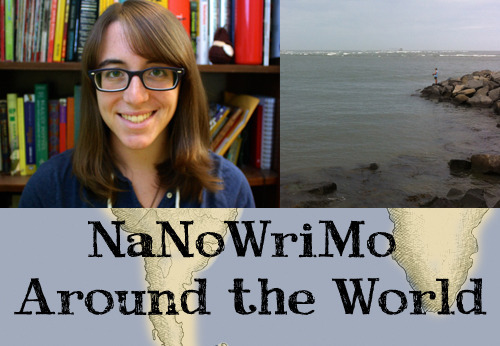
One of the best parts of NaNoWriMo? The incredible community of writers that gathers every November. Today, we spotlight Cole Altmann, part-time Philadelphia lighthouse resident, full-time aspiring writer :
Cole: Right now, I’m writing from my hometown of Philadelphia! The writing community in Philly, with the awesome tagline “Known for ambitious writing sessions since 1776,” is ridiculously active and supportive.
I’ve spent the last few years going back & forth between the city & the New Jersey coast during grad school, doing a variety of museum jobs from cleaning dinosaur fossils to working in a lighthouse.
What is unique about where you are writing form?
Cole: My favorite place to write is near the lighthouse, on the lower part of a rocky seawell. I’m a sucker for the ocean and it’s easy to be inspired by the setting of a lighthouse on an inlet, especially on mornings when heavy fog makes it so only the top of the tower is visible. What’s lurking in that mist? I don’t know but I’m sure that my overactive imagination is about to come up with a few ideas.
Working in and visiting museums always provides inspiration, whether through the artifacts I come across (I probably would have tried to hug the Rosetta stone if it hadn’t been behind glass), the setting (examining 18th century documents while hearing horse-pulled carriages outside one of the museums is surreal), or the daily interactions with visitors (“Yes, there are still working lighthouses in the world, sir. You’re in one”).
How would you describe your writing set-up in six words?
Cole: Hearing possible squirrels in the attic.
Do you have any writing tips to share that have been inspired by your NaNoWriMo 2013 experience?
In terms of writing tips: always carry a pen/pencil and a notebook with you. I don’t care if you have the greatest application on the most advanced phone, you can’t control the universe (so I’ve learned). You also can’t control a phone’s percentage of battery life or, say… dropping it in the ocean…
It’s always good to have backups, in any and all forms.
December 18, 2013
P4A: National Novel Writing Month! :: Project For Awesome 2013
You can help us grow National Novel Writing Month and the Young Writers Program with just one click! Vote for us at the link above before midnight, and check out the other great nonprofits on the projectforawesome.com site!
Come Write In Anywhere! Jes Andersen On Writing in Two Languages

Our Come Write In program has partnered with bookstores and libraries around the world for four years. This November, for the first time, we welcomed community spaces of all kinds to become novel-writing havens. Intern Steve Genise talks with Danish librarian Jes Andersen about the benefits of writing your novel in two languages at once! (Sadly, the conversation is only in one language):
First, how did you hear about the program?
I first heard of NaNo two years ago, when I was approached by a British expat English teacher who had introduced it to her international class of 15 year olds here in Fredericia. They needed a place to meet up, and that ended up being at our library.
I thought NaNo was brilliant, so I hosted a gathering at the end of the month, where the participants read from their stories and were filmed for the library’s website. Last year, the library had the full CWI experience, and I decided to give it a go myself as well.
How popular is NaNo in Denmark?
I don’t think NaNo is very established in Denmark yet. I know there’s a Facebook community based in Copenhagen, and another CWI community in Aarhus, both based at public libraries like us.
One of the things we hope to get out of NaNo this year is to attract attention to a bootcamp for young writers, which we’ll be starting up in the coming year.
Do you write your novels in English or Danish?
I wrote my novel last year in both English and Danish, with the real world being in Danish, and an imaginary, internal, world being in English. Most of the young adult participants wrote in Danish, but a couple wrote in English.
I think that I might give fan fiction a go, too. I love the idea of taking on an established universe and expanding it.
English and Danish? That’s probably the coolest thing I’ve ever heard. How did you first come about the idea of writing your novel in two languages?
To me, the idea was pretty straight forward, as soon as I knew that I wanted to have an internal world alongside the real world. Probably because most of the time I think in English anyway, even though I speak Danish.
For our other bilingual participants, what are some of the advantages you see in writing your novel this way?
One advantage for me was that it’s easier to make the novel personal, as English isn’t as hard to express feelings in as Danish is. It’s also a great way to clearly separate characters and storylines.
It does however make it pretty much impossible to imagine ever publishing the novel, as Danish is a tiny language to begin with, and the percentage of Danes who read English for leisure is relatively small. Luckily, I wrote my novel just for me, but if you want to get published it’s something to consider very hard before starting your novel.
I know many North-Germanic languages form large compound words that could even be four or five words in English. Do you find it more difficult to reach the 50,000 words because of this?
I think you have a point here. Writing in English often gives you two words for the price of one Danish word. If we were counting the letters and not the words, we Danes would win much faster.
However, I don’t think it’s all-important to reach 50.000 words, and most of our local participants set themselves more realistic targets, like 10.000 or 30.000 words, which I still think is a great achievement for students writing alongside their regular homework and social activities.
Jes Andersen is a librarian at the Fredericia Bibliotek in Fredericia, Denmark. If you’re interested in checking out their website and learning more and also happen to speak Danish, you can visit www.fredericiabib.dk.
December 17, 2013
P4A: National Novel Writing Month! :: Project For Awesome 2013
Project for Awesome 2013 is here! Awesome folks like you donate to, and create videos for their favorite nonprofits. Check out Kristina Horner’s awesome video for us, and the other awesome videos on projectforawesome.com!
This year, National Novel Writing Month helped 310,000 people on all seven continents raise their voice and tell their stories. Our Young Writers Program worked with more than 80,000 educators and students to promote writing fluency through free classroom resources, Common Core curriculum, and virtual classroom tools. Stories matter. Your story matters. Consider voting for us, and let’s decrease worldsuck today!
December 16, 2013
NaNoWriMo 2013: By the Numbers
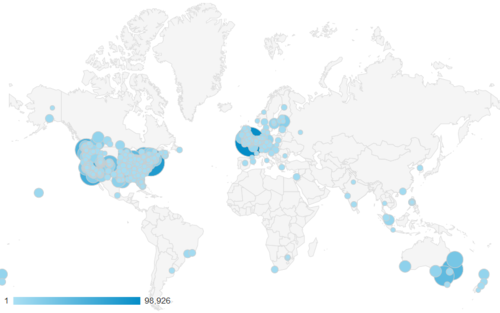
Check out our statistics for NaNoWriMo 2013! Our writers rocked this year as hard as usual—beating 2012’s winner number and words per person. And the Young Writers Program program continues its hot streak of 20%-and-up win rates. See below for even more facts and stats, including our website visitors (nearing a milli) and top NaNoWriMo cities.
And thanks for contributing to these awesome, humbling numbers!
NaNoWriMo by the Numbers
310,095 participants
3,520,123,164 total words
11,352 words per person (on average)
42,221 winners (14%)
The Young Writers Program by the Numbers (Note: This includes only our online participants; classroom students are not included.)
89,500 participants
444,585,841 total words
4,967 words per person (on average)
18,670 winners (21%)
Website Activity (during November)
949,147 unique visitors
36,680,504 pageviews
Top 50 NaNoWriMo Cities (based on visits during November)
London
New York
Los Angeles
Seattle
Sydney
Toronto
Chicago
Melbourne
Denver
Brisbane
Portland
San Francisco
Houston
Austin
Calgary
Minneapolis
San Diego
Helsinki
Phoenix
Boston
Ottawa
Albuquerque
San Antonio
Philadelphia
Perth
Washington
Dallas
Nashville
Montreal
Vancouver
Edmonton
Dublin
Columbus
Adelaide
San Jose
Colorado Springs
Auckland
Atlanta
Tucson
Boise
Stockholm
Indianapolis
Berlin
Leeds
Madison
Alexandria
Manchester
Charlotte
Singapore
Salt Lake City
Top 50 NaNoWriMo Countries and Territories (based on visits during November)
United States
United Kingdom
Canada
Australia
Germany
Netherlands
France
Sweden
Finland
Brazil
New Zealand
Norway
Ireland
Spain
Philippines
Denmark
India
South Africa
Japan
Belgium
Austria
Mexico
Singapore
Italy
Poland
Switzerland
Malaysia
South Korea
Hungary
Portugal
Indonesia
Israel
China
Russia
Czech Republic
Croatia
Latvia
Romania
Hong Kong
Thailand
Greece
Argentina
Puerto Rico
Turkey
United Arab Emirates
Estonia
Slovenia
Taiwan
Chile
Bulgaria
December 13, 2013
Young Writer Chronicles: The Benefits of an Immersive Writing Environment
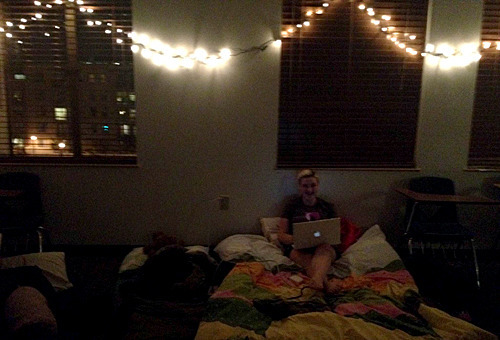
High school students at the Oakland School for the Arts have been participating in NaNoWriMo’s Young Writers Program for years. This year, led by educator Kate Schatz, they had a NaNoWriMo that made us at HQ jealous.Today, Chloe tells us how her writing community inspires her:
This year is my fourth year in OSA’s Literary Arts department and my fourth year doing NaNoWriMo. However, much to my excitement, this is the first year that we’ve really come together as a community of writers and supported each other’s stories.
One of the ways we did this was through a literary lock-in. We separated into two rooms - the quiet writing room and the novel discussion/hangout/let’s-watch-movies-for-inspiration room. In the quiet writing room, we developed a schedule where we would alternate forty-five-minute writing sprints and fifteen-minute breaks throughout the night.
Some of us sat down and wrote three thousand words over three writing sprints then tucked in for a movie and a night of sleep, while others only wrote fifty to a hundred words, choosing to use the writing community as an inspiration and a means to straighten out one’s story.
It wasn’t all work, of course. A specific memory that I have is sneaking away with three other students to the far stairwell and playing a few games of Apples to Apples and other writer-y games before returning to our novels. As the night dwindled on, the quiet writing room got quieter and quieter as students moved to sleep or talk or write alone in the halls. By about three thirty, the room was down to five kids, myself included, still writing diligently.
Being in an environment where everyone was writing at the same time really pushed me to just keep going. Even when I felt like my plot was stuck, I could easily run out of the quiet room and into the other room, yell anything from “What do I name this character?” to “What would five teenagers from 2013 trapped in 1989 Chicago want to do if they only had 20 minutes?” and get an armada of answers to work with.
At the end of the day (night?) I ended up writing about 5,000 words of my novel - which, as my goal is 30,000, is 1/6th of the final goal in one night. It was an experience I don’t plan to forget anytime soon. Maybe it’ll even be the plot for my next novel.

Chloe Ashley is a senior in high school whose work is forthcoming in Generations Literary Magazine . She hopes one day to have fanfiction written about her characters and has had her hair at least fifteen different colours.
December 11, 2013
I Published My NaNo Novel: Anthony Francis Jr. on Writing Your Next Novel
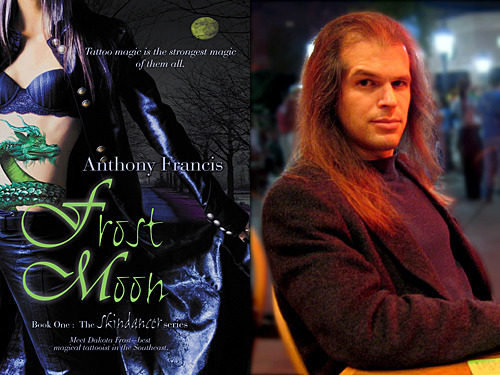
Anthony Francis is a long-time NaNoWriMo participant, who’s recently published the first book in his series about Dakota Frost, a tattoo artist with magical powers. We talked with him about revision, publication, and 24-Hour Comics Day:
The first two books in your SkinDancer trilogy started as NaNo drafts. Can you talk about them?
Yes! The cores of both Frost Moon and Blood Rock were written during NaNoWriMo. I’d been planning ideas around my protagonist, a magical tattoo artist named Dakota Frost, and had written a couple of hundred words when November rolled around and I decided to tackle NaNo.
I became so happy with Frost Moon that I started working on a second book, which became Blood Rock. I had 12,000 words before November, and tacked on another 50,000 during the course of the month. That’s when I decided that I didn’t care about following the rules specifically. Every November, I’d pick a novel—unwritten or not—and add 50,000 words to it, and that would be my challenge. And I’ve done it ever since!
After November’s over, revision time inevitably rolls around. Do you have any advice for those of us who will soon be struggling in the revision doldrums?
Never give up!
NaNoWriMo requires 50,000 words, but typically my novels pack in between 90,000 to 150,000 words—so I need to keep writing for a year or more after NaNo to finish a novel. I always want to start an essentially new novel for NaNo, so I end up having several novels in progress at any one time. This is great, as you can work on whichever one inspires you most at any given moment.
You are also involved in a great event called 24-Hour Comics Day. Can you explain what that is?
24-Hour Comics Day is a yearly challenge to create a completely new comic in 24 hours. I’ve completed 24-Hour Comics Day three times—each time, taking on a part of a novella I wrote called “Stranded.” This year, I completed the third part, so I have a complete graphic novel of one of my stories!
How is 24-Hour Comics Day similar to NaNoWriMo?
Both 24HCD and NaNoWriMo convince you not to wait for the muse. In my opinion, I’m a much better writer than I am an artist, and my self-consciousness can get in my way. 24HCD cures you of that, the same way that NaNo cures you of the idea that you need to be inspired to write.
This year, 24HCD was especially good for that for me because some of what I thought was my very best art didn’t hold up once I went back to look at it later, whereas some of my sloppiest drawings—drawings in which I can see and point out the flaws—nonetheless served the narrative perfectly. NaNo’s the same way: some of my very best material comes out of the raw terror of needing to produce 1,666 words… on a day when I had nothing.
The purity of the challenge doesn’t matter as much to me as the challenge of stepping up to the plate and giving yourself permission to create.
Any tips on publishing your novel?
Start writing your next novel.
Seriously. I wrote a novel twenty years ago and spent years trying to get it published. (It still isn’t). But, one day, I read an interview with a published fantasy author, who was working on his fifth novel when his first one finally got published. So I kept writing. Years later, Dakota Frost #1 sold while I was working on #2.
There are lots of theories about why this works. It could be that publishers love authors who’re working on their next manuscript. It could be that you learn so much from writing more novels that you improve your first manuscript until it sells. Maybe the change in your attitude helps sell your manuscript, whether you change the manuscript or not. Maybe the continued act of writing puts it out to the universe to open the door to your publication, or maybe it’s just dumb luck multiplied by the passage of time. Or perhaps it’s like writing a prayer to God, who finally answers.
I personally think it’s all of the above… plus one more thing: putting yourself into places filled with the people who read, write and publish the kind of work that you like. If you hide in a cupboard, you’re unlikely to get published—at least, not while you’re alive. But if you regularly attend a writer’s group, you’ll hear about an anthology. If you go to a literary conference, a great writer might take you on as an intern at their magazine. If you go to a publishing conference, you might meet an agent.
As for me? I went to writer’s tracks at science fiction conventions, and then one day the organizer of the track leaned over my shoulder and asked, “I see you in here every year. What are you writing?” That was Nancy Knight, of Bell Bridge Books, a southern women’s fiction publisher which had just opened a dark fantasy line… and I was writing the second Dakota Frost book, an urban fantasy set in Atlanta. Nancy got me in touch with Debra Dixon of Bell Bridge, and the rest is history.
Well, lots and lots of edits—Debra’s a great editor!—and then history.
Dr. Anthony G. Francis, Jr. is a science fiction writer and computer scientist. The Dakota Frost series combines Anthony’s love of hard science, fantastic magic, alternative culture, and strong women. Anthony blogs about his life, his writing and his research at The Library of Dresan. He also writes an occasionally updated webcomic, f@nu fiku. He currently lives in San Jose with his wife and cats.
December 9, 2013
Come Write In Anywhere! Sarah Manzano on Introducing NaNoWriMo to Bulgaria
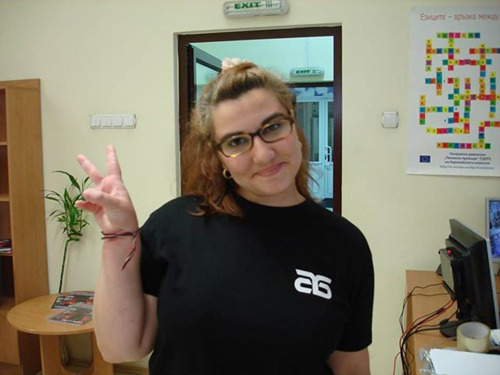
Our Come Write In program has partnered with bookstores and libraries around the world for four years. This November, for the first time, we welcomed community spaces of all kinds to become novel-writing havens. Development Intern Steven Genise spoke with Sarah Manzano, a member of the European Volunteer Service, who traveled from Spain to Bulgaria, and brought NaNoWriMo with her.
So you are originally from Spain, but are now living in Sofia, Bulgaria. What took you all the way across Europe?
I’m doing an EVS (European Voluntary Service) at the Sofia City Library, the biggest public library in the capital of Bulgaria. I’m going to stay here for six months. Part of my work consists of helping with the normal running of the library day to day. But (this is the important point), every volunteer has a Personal Project, and mine was to convert the library into the first Come Write In location in Bulgaria, teach about creative writing in general, and spread the love of NaNoWriMo.
How popular is NaNo in Spain? How many times have you participated in the past?
For me, this would be my tenth year (yes, wow), but I have to confess that so many years I haven’t successfully finished because I had a lot of work to do. I’ve won two times, and I sometimes participate in Camp NaNoWriMo, too.
In the big cities, like Madrid or Barcelona, there are groups of people who meet to write together during NaNoWriMo. I live in a small town in the south of Spain, and we don’t have a space for Come Write In, but who knows? Maybe next year we’ll have one…
Having been a longtime Wrimo, most of your Novembers have been spent in Spain. What was it like doing NaNo in another country?
This November was a difficult month for me. Not only because I am in another country, but because November was my last month in Bulgaria and I had a lot work to do before coming back home.
I really don’t think it matters what country you are writing in though; NaNoWriMo is more a state of mind. Although I always do NaNo at home in Spain, the best way of communication (for the inevitable cries of desperation) is the internet. It’s always good to keep in touch with other people who are doing NaNo by chat, email, Twitter, or the website. These people can understand you, and, during November, this is the most important.
Bulgaria has never had a CWI before. Do you suspect you’ll be hailed as a hero for introducing the country to NaNo? When they build a statue of you in the center of the library, would you prefer marble or bronze?
For me, the most important thing was to attract people to the library! Nowadays, libraries are not very popular places, so with this project I want to show that they are fun places, a place not only to pick up a book and go, but a place to stay and enjoy.
NaNoWriMo offers a lot of fun, and a great way to meet other people who are interested in the same things as you!
In any case, I prefer marble: it is more resistant over time.
Sarah Manzano is a member of the European Volunteer Service, traveler of all of Europe, and soon to be model for a marble statue in front of a Bulgarian library. She keeps two blogs, one in English and one in Spanish , where you can find more about her EVS project and Write In program!
December 6, 2013
Taking Your Novel to the Next Step with CreateSpace
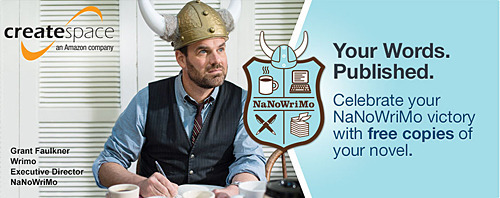
CreateSpace is one of our longest-running sponsors. This year, they return to provide free paperback copies of your novel. We reach back and hear from awesome writers who’ve worked with CreateSpace, and walk you through how to redeem your copies:
“There’s nothing better than holding the finished product of all your hard work in your hands.” — NevadaPaul
Now that you’ve finished the world’s ultimate noveling marathon, we have the ultimate prize for you to take your novel to the next step. Thanks to CreateSpace, a longtime NaNo sponsor, all NaNoWriMo winners are now eligible for two free printed paperback copies of their published manuscripts!
Imagine that—a whole book that you wrote, in your hands.
"My motivation has been revived." — Harmonyturtle28
Printing out your manuscript can be a great tool to get excited again about your novel. After all, reading a bound copy is one of the best ways to edit: it helps you envision the writing as a real thing, allows space for corrections in the margins, provides you with the objectivity you might not have while reading it on the computer, and makes it easier to give copies to a beta reader.
"I am ready and can visualize these books on my shelf.” — Njhaefner
Utilizing this offer from CreateSpace can also be an important first step to eventually broadening the distribution of the novel you wrote this year. You don’t have to use the copies as an editing or publishing tool, though—they can make the perfect present for family, friends, or even yourself.
“CreateSpace is great to use, especially for first-time authors! (I used it just a few months ago for my first novel).” — UVCW
Worried the process of receiving your paperback copies will be complicated? It’s more straight forward than ever (for even more details check out their thread here):
How to Redeem Your CreateSpace Code
Starting December 5, all NaNoWriMo winners will head to the Winner Prizes block on the NaNoWriMo homepage. There, you’ll see your unique NaNoWriMo winner’s code, which expires on June 30, 2014.
If you haven’t already, create an account on CreateSpace here.
Publish your book through CreateSpace.
After publishing, redeem the code on CreateSpace while ordering your books. It is good for two free copies. CreateSpace will cover printing costs, but you will have to cover shipping costs.
Again, the offer is only good on books published through CreateSpace. They have a variety of different distribution channels, ranging from being available widely on Amazon.com and Amazon’s European websites to private options.
If you have any questions about the offer, please contact CreateSpace! They would love to answer your questions.
Chris Baty's Blog
- Chris Baty's profile
- 63 followers



